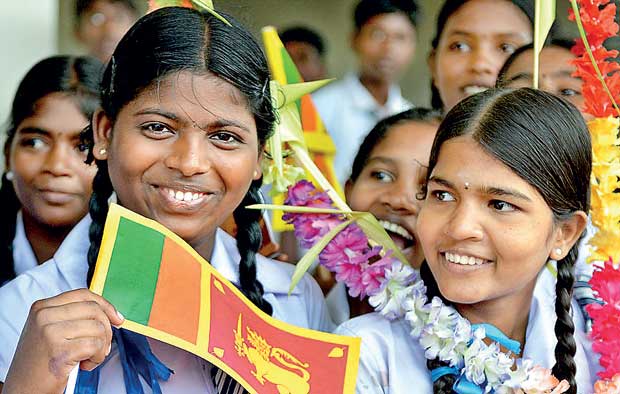Reply To:
Name - Reply Comment
Last Updated : 2024-04-20 03:33:00

“Every miserable fool who has nothing at all of which he can be proud, adopts as a last resource pride in the nation to which he belongs; he is ready and happy to defend all its faults and follies tooth and nail, thus reimbursing himself for his own inferiority.”
~ Arthur Schopenhauer, Essays and Aphorisms
 Kadiresan woke up early morning, a couple of hours before sunshine, looked up towards the starless skies and let out a deep sigh; he knew it was going to be another scorching, hot day in the peninsula. In the distance, beyond a parched landscape full of palms and groves lay his oasis of land; although it was only a quarter of an acre in area, it was watered regularly and with the rich red soil to nourish a crop of vegetables from cauliflower to beets, carrots and red onions, Kadiresan knew that his harvest promised more than an average cash inflow into his family of three, his wife and a school going daughter who was only seven years old and quite bright in her studies. Kadiresan managed to get his daughter admitted to the great Vembadi Girls High School, which according to some educators, is the best secondary school in all of Sri Lanka, surpassing Ananda, Royal, Nalanda,and other elite schools in the Island.
Kadiresan woke up early morning, a couple of hours before sunshine, looked up towards the starless skies and let out a deep sigh; he knew it was going to be another scorching, hot day in the peninsula. In the distance, beyond a parched landscape full of palms and groves lay his oasis of land; although it was only a quarter of an acre in area, it was watered regularly and with the rich red soil to nourish a crop of vegetables from cauliflower to beets, carrots and red onions, Kadiresan knew that his harvest promised more than an average cash inflow into his family of three, his wife and a school going daughter who was only seven years old and quite bright in her studies. Kadiresan managed to get his daughter admitted to the great Vembadi Girls High School, which according to some educators, is the best secondary school in all of Sri Lanka, surpassing Ananda, Royal, Nalanda,and other elite schools in the Island.
Kadiresan’s journey has not been an easy one. His middle-class parents bequeathed the land and other properties to him via Thesavalamai law. Whereabouts his parents are yet unknown and that is after the war. Right through the life story of Kadiresan flows the tale of our Tamil brethren in the North and some parts of the East. It is absolutely futile to run through the history of Tamils and try to portray a picture of negativity or one of positive genre, depending on the reader’s prejudices. Erudite historians and scholars may disagree with me when I point out that ‘you see one, you see all’ notion applies to Northern Tamils. However, the canvass that I intend to paint on seems too broad and the finesse and training that a specialist historian needs, I confess, I do not possess. Yet, the simple, but not simplistic, approach I intend to take would have equipped me to confront the issues that our Tamil brothers and sisters had to face over the last century or so.
However, my task here is not to catalogue what had happened in the past, ancient or modern, the various events that had provoked the subsequent actions by succeeding generations, sometimes as a response to the varied State-sponsored or otherwise-underwritten legislations, regulations, constitutional changes or proactive measures initiated by the Tamil leaders over the last few decades. But I can certainly talk about events and proceedings that had a direct or indirect effect on the overall status of the mindset and psyche of a community that has been sharing the same land, traditional values and cultural bonds with the majority which happens to be Sinhalese Buddhist.
Human values whether they are born and nurtured by one community or another do not dis-empower our inherent powers. On the contrary, they enrich the very core of our being, they continue to upgrade our responses to various crises and every now and then catapult us from treacherous chasms to subliminal heights. When crises that are born essentially out of prolonged suppression of a people, in India in the eighteen hundreds and early nineteen hundreds, the world was blessed to see a Mahatma Gandhi; in the nineteen fifties and sixties in America we saw Martin Luther King Jr.; in the latter part of the Twentieth Century we saw Mandela in South Africa. All these leaders managed to stay above the fray and transcend the mundane issues that irritate and annoy people at large.
The Tamil Question in Sri Lanka could be analyzed and understood only in the context of a rich environment of two able but inwardly narcissistic communities battling it out in the dark shadows of racial discrimination and ethnic mistrust. However rich the respective histories of these two communities, Sinhalese and Tamils, when it came to real decision-making levels, discrimination and mistrust crept in and any resolution to the issues at hand got buried under a sandstorm of vitriolic barrage and non-participation at meaningful discourse of real propositions. I have written earlier and I would not hesitate to repeat now, any attitudinal changes that are essential to a long-lasting resolution of the fundamental divisions and breakdown of mutual trust and faith have to be preceded by objective changes in our societal structures and societal makeup. As much as the ‘56- transformation made a change in the psyche and mindset in the Tamil people, the Thirteenth Amendment did have a very serious and grave adjustment in the mindset of the majority Sinhalese Buddhists. The ‘minority mindset’ that has crippled the minds of our majority Sinhalese and provoked them to pogrom-like massacres of innocent Tamil civilians in the South as was evidenced in the ‘83 ethnic riots was given additional fodder when the Thirteenth Amendment was passed in Parliament under severest of conditions in the country in 1987. The political leadership in the Opposition was led by the SLFP and further strengthened by the then JVP which had turned into an ultra-chauvinistic protest group which later graduated into a mindless killing machine in the ’87 – ’89 ‘Second Revolution’ phase.
The Liberation Tigers of Tamil Elam, (LTTE) led by a murderous Prabhakaran of the Northern Tamils on the one hand and Rohana Wijeweera and Deshapremi Janatha Vyaparaya (DJV) - Patriotic People’s Movement- an even more ruthless killer-group of the Sinhalese Buddhists on the other, held the nation and the central government led by an Executive President to ransom, particularly between 1987 and 1989. Sharpening of the already distorted mindsets had already occurred and what was necessary was the settling of the residue at the bottom of the barrel. Two peoples, who boast about their respective cultural heritage, two peoples who claim two non-violent religions- Buddhism and Hinduism- as their religious foundation, two peoples who are seen almost each Sunday at the front entrance of their ‘Temples’ were entangled in a bitterest of all bitter battles, some at the negotiating table, Colombo, Timpu, Bangalore etc and more in the thickest jungles of Mullaithivu, Vavuniya, Kilinochchi and Jaffna.
In quelling these two wars, one commandeered by Prabhakaran and the LTTE and the other by Wijeweera and the JVP, General Sarath Fonseka and Ranjan Wijeratne, both battlefield leaders, showed remarkable traits of leadership from the front. And at both these violent uprisings, Sri Lanka showed the world that she is not ready nor is she willing to surrender to the whims and fancies of dictatorial and unrealistic leaders in the likes of Prabhakaran and Rohana Wijeweera. With all her flirtations with so-called revolutions and militant-led uprisings, Sri Lanka is yet to succumb to the unknown devil. That is the lesson that all our political leaders should learn.
In recent history, the ‘Tamil Question’ was argued by the Ponnambalam brothers, C. Sunderalingam and G.G. Ponnambalam in the Legislative and State Councils and later in Parliament by Chelvanayagam, Amirthalingam and others. Demands from ‘Fifty-Fifty’ to Tamil ‘Traditional Homeland’ have done their usual rounds in the corridors of discussion in local and international domains. The violent expressions rendered unto these demands have been defeated with equal or even more ferocious violence. A caste-ridden community in its most discriminatory form, Tamils at one time were led exclusively by the Vellala caste leaders until Prabhakaran appeared on the horizons of Valvedditturai. When Prabhakaran took over the leadership of the Tamil militant struggle, the Colombo elites of the Tamil community buckled down and their ‘Vellala-ness’ was thrown out the window. At that time, all power ran through the barrel of the LTTE guns. Wijeweera too tried these tactics in the ’87 – ’89 struggle, but could not subject the majority Sinhalese community to his will and guns. However, in history’s strangest of ironies, Sri Lanka Freedom Party (SLFP) although named as a ‘common man’s’ party, founded by a Sinhalese, Govigama, low-country, aristocrat, remains a political party, led exclusively by a man or woman of Govigama origin. In the SLFP, when caste is the issue, common man ceases to exist.
In this convoluted context, the Tamil Question remains unsettled to date and the mistrust the Tamil leadership holds against its Sinhalese counterparts has contributed to the aggravation of the issue. Prabhakaran managed to kill almost all of the moderate Tamil leadership; Amirthalingam, Yogeswaran, Thiruchelvam and Kumar Ponnambalam are all not in the land of the living; after the defeat of the LTTE forces in 2009, the leadership of the Tamil community once again has fallen on the shoulders of the leaders who belong to Vellala caste. How other caste-MPs are treated by the leadership is totally another matter. Yet this caste issue, though invisible to society as an obvious notion of grave division and discrimination, continues to keep the Tamil community, a people dwelling in a past once torn apart by this anachronism withholding talented and able men and women from the upper echelons of community leadership.
If the leadership of both communities need to resolve this irksome problem that has been haunting the souls of our people, they need to start afresh; they need to negotiate on a clean slate; they need to shed all their past prejudices, past philosophies, past mistrusts and everything that stood as an impediment to a long-lasting solution to the Tamil Question. One cannot go forward if one cannot forget the past. Future is not a mirage; it is a very real thing. One cannot step into that future with age-old baggage. Are our present leaders ready for that kind of a relationship? Are they capable of thinking of such an adventurous beginning, leave alone taking action on it? Otherwise, Kadiresan’s toiling is in vain; his sweat is in vain, his very existence would be in vain. H.G. Wells said long time ago that, “Our true nationality is mankind”. Let us be worthy of it.
The writer can be contacted at vishwamithra1984@gmail.com

Add comment
Comments will be edited (grammar, spelling and slang) and authorized at the discretion of Daily Mirror online. The website also has the right not to publish selected comments.
Reply To:
Name - Reply Comment
On March 26, a couple arriving from Thailand was arrested with 88 live animal
According to villagers from Naula-Moragolla out of 105 families 80 can afford
Is the situation in Sri Lanka so grim that locals harbour hope that they coul
A recent post on social media revealed that three purple-faced langurs near t